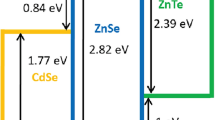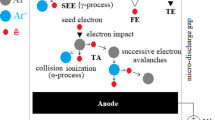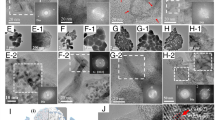Abstract
We have applied Coherent Anti-Stokes Raman Spectroscopy (CARS), using a narrowband, scanned colinear configuration, to measure temperatures, relative concentrations, and detect species in low pressure CVD of polycrystalline diamond. CARS measurements were obtained for methane, hydrogen, and acetylene in either or both a rf plasma reactor and a hot filament reactor. In the rf PACVD experiments a mixture of 1% CH4 in H2 was used at a total pressure of 5 torr. The rf power input to the plasma was 300 watts and the H2 and CH4 flow rates were 99 and 1 sccm, respectively. As acetylene (C2H2) has been proposed as an intermediate in diamond growth, it was selected for the initial series of measurements. In the absence of rf power, a sensitivity of 5 mtorr was observed; in the plasma downstream of the rf coils, no observable signal attributable to C2H2 was evident. This places an upper limit to conversion of methane to acetylene at 20%, a figure representing the observed sensitivity to C2H2. In the hot filament reactor, the gas flow was 200 sccm of 1% CH4 in H2 at a total pressure of 150 torr. Under these conditions, C2H2 was detectable. Absolute concentrations were not calculated, but the observed spectra are within an order of magnitude of our sensitivity limit. This allows estimation of the C2H2 partial pressure near the substrate as 5–50 mtorr or from 0.66 to 6.6% conversion from methane. In view of this low conversion percentage, the absence of a signal in the rf experiments must be taken as inconclusive. CARS spectra of methane were also obtained in both reactors. In the rf reactor, under similar conditions to those described previously, the methane relative concentration decreased to 25% as the rf power was increased from zero to 400 watts. In the hot filament reactor, CH4 CARS signal profiles were obtained as a function of axial distance from the hot filament, and parametrically as a function of filament temperature. Comparison of these profiles, in which the observed signal decayed monotonically as the filament was approached and increased monotonically downstream of the filament, was made with theoretical calculations. This comparison showed that the fluctuations were attributable to temperature/pressure effects and not to chemistry. To determine if the observed depletion in the rf plasma was similarly attributable, the CARS signal of hydrogen was observed as a function of axial distance downstream of the rf coil centerline and parametrically as a function of rf power. In contrast to expected behavior in the thermal hot filament reactor, little rotational excitation was observed in the plasma. Rotational temperatures were assigned to hydrogen based upon comparison with theoretically derived spectra. At 450 watts of rf power, rotational temperatures of 340 K were observed 4 to 6 cm downstream of the coil, the region where the 25% decrease in CH4 was observed. Little or no density fluctuations accrue due to these temperatures, indicating that the observed depletion in methane signal is attributable to decomposition or chemical reaction in the plasma. In summary, CARS is applicable to reactant species (CH4) axial profiling in both reactors, but can be limited by sensitivity in the detection of intermediate or product species (C2H2). In addition, CARS thermometry can be utilized to profile the rotational temperatures of selected species.
Similar content being viewed by others
References
F. Celii, P. Pehrsson, H. Wang, and J. Butler, Appl. Phys. Lett. 52 (24), (June 1988).
N. Ohtake and M. Yoshikawa, J. Electrochem. Soc. 137 (2), 717–722 (1990).
A. Sawabe and T. Inuzika, Appl. Phys. Lett. 46 (2), 146–147 (1985).
W. Yarbrough and R. Messier, Science 247, 688–695 (1990).
S. Matsumoto, Proc. 7th Int. Symp. on Plasma Chemistry, Einhoven, edited by C. J. Dimmermans, 1, 79–84 (1985).
Y. Hirose and N. Kindo, paper presented at the Japan Society of Applied Physics Symposium, Tokyo, Japan, March 1988.
B. Singh, Y. Arie, A. Levine, and O. Mesker, Appl. Phys. Lett. 52, 451 (1988).
N. Fujimori, A. Ikegaya, T. Imai, K. Fukushima, and N. Ohta, Proc. 1st Int. Symp. on Diamond and Diamond-Like Films, edited by J. P. Dismukes, A. J. Purdes, K. E. Spear, B. S. Meyerson, K.V. Ravi, T. D. Moustakas, and M. Yoder (The Electrochemical Society, Pennington, NJ, 1989), pp. 465–474.
A. Deutchman, R. Partyka, and J. Lewis, “Room Temperature Deposition of Diamond Films with the New DIOND Dual Deposition”, Proc. of SDIO/IST-ONR Diamond Technology Initiative Symposium paper no. T3, Crystal City, VA, July 1989.
Y. Lifshitz, S. Kasi, and J. Rabalais, “In Situ Parametric Studies of Diamond Film Growth from Low Energy, Mass Selected Carbon Beams,” Proc. of SDIO/IST-ONR Diamond Technology Initiative Symposium paper no. TP7, Crystal City, VA, July 1989.
A. C. Eckbreth and J. Stufflebeam, in Process Diagnostics: Materials, Combustion, Fusion, edited by A. K. Hays, A. C. Eckbreth, and G.A. Campbell (Mater. Res. Soc. Symp. Proc. 117, Pittsburgh, PA, 1988).
A. C. Eckbreth, Laser Diagnostics for Combustion Temperature and Species (Abacus Press, Tunbridge Wells, Kent, U.K., 1987).
W. C. Roman, M. B. Colket, S. O. Hay, and A. Eckbreth, “CARS Diagnostics and Analysis of Species in Diamond Deposition Process,” Presentation at the 1st Int. Symp. on Diamonds and Diamond-Like Films,” Electrochemical Society Meeting, CA, May 7–12, 1989.
W.C. Roman and A.C. Eckbreth, “CARS Detection of Gaseous Species for Diamond Deposition Processes,” 197th ACS National Meeting, Dallas, TX. Division of Fuel Chemistry Preprints 34 (2), 508–516 (1989).
W. C. Roman, J. Stufftebeam, and A. Eckbreth, in Process Diagnostics: Materials, Combustion, Fusion, A. K. Hays, A. C. Eckbreth, and G. A. Campbell (Mater. Res. Soc. Symp. Proc. 117, Pittsburgh, PA, 1988).
K. Spear and M. Frenklach, “Mechanistic Hypothesis on Diamond Growth from the Vapor”. Presented at 3rd SDIO/IST-ONR Diamond Technology Initiative Symposium, Arlington, VA, July 1988.
R. P. Lucht and R. L. Farrow, “Saturation Effects in Coherent Anti-Stokes Raman Scattering of Hydrogen: An Experimental and Theoretical Investigation”, Sandia Report SAND89-8479, Sandia National Laboratories, Livermore, CA, 1989.
A. Sherman, Chemical Vapor Deposition for Microelectronics (Noyes Publications, NJ, 1987).
S.Y. Matsumoto, M. Kamo, J. Tenaka, and N. Setaka, “Chemical Vapor Deposition of Diamond from Methane-Hydrogen Gas”, Proc. 7th Int. Conf. on Vac. Metallurgy, Tokyo, Japan, pp. 386–391, 1982.
S. Solin and A. Ramdas, Phys. Rev. B 1, 1687–1698 (1970).
W. C. Reynolds, “STANJAN, Interactive Computer Programs for Chemical Equilibrium Analysis”, Stanford University, January 1981.
R. J. Kee, J. A. Miller, and T. H. Jefferson, “CHEMKIN: A General-Purpose, Problem-Independent, Transportable, Fortran Chemical Kinetics Code Package”, Sandia National Laboratories, SAND80-8003, March 1980.
J. Warnatz, in Combustion Chemistry, edited by W. C. Gardiner (Springer-Verlag, New York), pp. 197–360.
S. J. Harris, A. M. Weiner, and T. A. Perry, Appl. Phys. Lett. 53 (17), 1605–1607 (1988).
F. G. Celii and J. E. Butler, Appl. Phys. Lett. 54 (11), 1031–1033 (1989).
S. K. Friedlander, Smoke, Dust and Haze (John Wiley and Sons, New York, 1977).
S.E. Stein, J. Phys. Chem. 82, 566 (1978).
S.E. Stein and A. Fahr, J. Phys. Chem. 89, 3714–3725 (1985).
M. Frenklach, D.W. Clary, T. Yuan, W.C. Gardiner, and S.E. Stein, Combustion Science and Technology 50, 79–115 (1986).
Author information
Authors and Affiliations
Rights and permissions
About this article
Cite this article
Hay, S.O., Roman, W.C. & Colket, M.B. CVD diamond deposition processes investigation: CARS diagnostics/modeling. Journal of Materials Research 5, 2387–2397 (1990). https://doi.org/10.1557/JMR.1990.2387
Received:
Accepted:
Published:
Issue Date:
DOI: https://doi.org/10.1557/JMR.1990.2387




